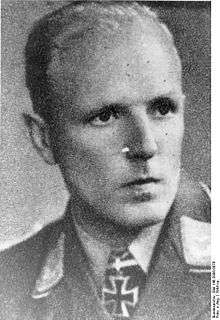Wilhelm Fulda
| Wilhelm Fulda | |
|---|---|
 | |
| Born |
21 May 1909 Antwerp, Belgium |
| Died |
8 August 1977 (aged 68) Hamburg-Wandsbek |
| Allegiance |
|
| Service/branch |
|
| Years of service | 1935–1945 |
| Rank | Hauptmann |
| Unit | JG 301, JG 302, JG 400 |
| Battles/wars | |
| Awards | Knight's Cross of the Iron Cross |
Wilhelm Fulda (21 May 1909 – 8 August 1977) was a highly decorated Hauptmann in the Luftwaffe during World War II, and a recipient of the Knight's Cross of the Iron Cross (German: Ritterkreuz des Eisernen Kreuzes). The Knight's Cross of the Iron Cross was awarded to recognise extreme battlefield bravery or successful military leadership.
Career
Wilhelm Fulda joined the military service on 1 November 1935. After completion of his glider pilot training he was assigned to the 17./Kampfgruppe z.b.V. 5 (17th squadron of the combat group for special assignments 5). His first combat mission was with Sturmabteilung Koch (assault battalion Koch) in the Battle of Fort Eben-Emael, flying and landing a DFS 230 assault glider, for which he was awarded the Iron Cross 1st class (Eisernes Kreuz 1. Klasse) on 13 May 1940. Fulda was awarded the Knight's Cross of the Iron Cross for his actions as a glider pilot during the attack on the Isthmus of Corinth, Greece. He led the Go 242 equipped 1./Schleppstaffel of Luftlandegeschwader 2 (2nd Air Landing Wing) from 4 September 1942 until 4 February 1943 before he transferred to the night fighter force and appointed Kommandeur of II./JG 301 in November 1943.
He became Kommandeur I./JG 302 in August 1944 and then of III./JG 301 the following month. With his extensive gliding experience Fulda was then transferred to I./JG 400 in November 1944.[1]
He was credited with the destruction of one four-engine bomber.[2]
Awards and decorations
- Iron Cross (1939)
- Knight's Cross of the Iron Cross on 14 June 1941 as Leutnant and [[Zugführer (platoon leader)]] of the 6./Fallschirmjäger-Regiment 2[4][5]
References
Citations
Bibliography
- Fellgiebel, Walther-Peer (2000) [1986]. Die Träger des Ritterkreuzes des Eisernen Kreuzes 1939–1945 — Die Inhaber der höchsten Auszeichnung des Zweiten Weltkrieges aller Wehrmachtteile [The Bearers of the Knight's Cross of the Iron Cross 1939–1945 — The Owners of the Highest Award of the Second World War of all Wehrmacht Branches] (in German). Friedberg, Germany: Podzun-Pallas. ISBN 978-3-7909-0284-6.
- Kurowski, Franz (1995). Knights of the Wehrmacht Knight's Cross Holders of the Fallschirmjäger. Atglen, PA: Schiffer Military. ISBN 978-0-88740-749-9.
- MacLean, French L (2007). Luftwaffe Efficiency & Promotion Reports: For the Knight's Cross Winners. Atglen, Pennsylvania: Schiffer Military History. ISBN 978-0-7643-2657-8.
- Obermaier, Ernst (1989). Die Ritterkreuzträger der Luftwaffe Jagdflieger 1939 – 1945 [The Knight's Cross Bearers of the Luftwaffe Fighter Force 1939 – 1945] (in German). Mainz, Germany: Verlag Dieter Hoffmann. ISBN 978-3-87341-065-7.
- Scherzer, Veit (2007). Die Ritterkreuzträger 1939–1945 Die Inhaber des Ritterkreuzes des Eisernen Kreuzes 1939 von Heer, Luftwaffe, Kriegsmarine, Waffen-SS, Volkssturm sowie mit Deutschland verbündeter Streitkräfte nach den Unterlagen des Bundesarchives [The Knight's Cross Bearers 1939–1945 The Holders of the Knight's Cross of the Iron Cross 1939 by Army, Air Force, Navy, Waffen-SS, Volkssturm and Allied Forces with Germany According to the Documents of the Federal Archives] (in German). Jena, Germany: Scherzers Militaer-Verlag. ISBN 978-3-938845-17-2.
- Thomas, Franz; Wegmann, Günter (1986). Die Ritterkreuzträger der Deutschen Wehrmacht 1939–1945 Teil II: Fallschirmjäger [The Knight's Cross Bearers of the German Wehrmacht 1939–1945 Part II: Paratroopers] (in German). Osnabrück, Germany: Biblio-Verlag. ISBN 978-3-7648-1461-8.
External links
- "Wilhelm Fulda". World War 2 Awards. Retrieved 27 July 2011.